stop and start RENAULT KADJAR 2015 1.G Workshop Manual
[x] Cancel search | Manufacturer: RENAULT, Model Year: 2015, Model line: KADJAR, Model: RENAULT KADJAR 2015 1.GPages: 298, PDF Size: 6.69 MB
Page 246 of 298
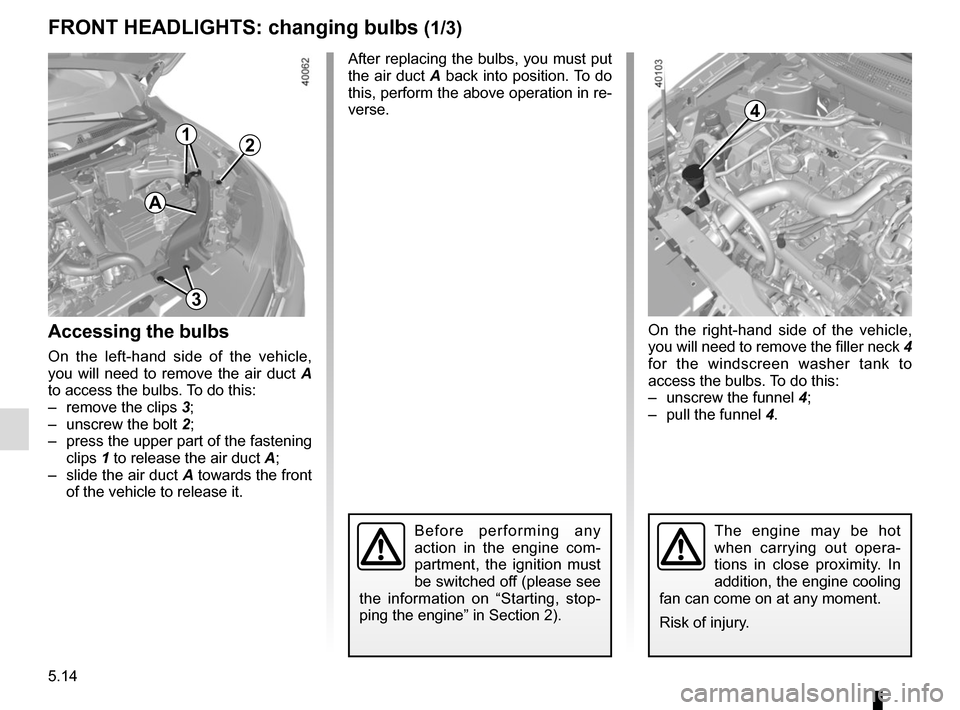
5.14
After replacing the bulbs, you must put
the air duct A back into position. To do
this, perform the above operation in re-
verse.
FRONT HEADLIGHTS: changing bulbs (1/3)
The engine may be hot
when carrying out opera-
tions in close proximity. In
addition, the engine cooling
fan can come on at any moment.
Risk of injury.Before performing any
action in the engine com-
partment, the ignition must
be switched off (please see
the information on “Starting, stop-
ping the engine” in Section 2).
Accessing the bulbs
On the left-hand side of the vehicle,
you will need to remove the air duct A
to access the bulbs. To do this:
– remove the clips 3;
– unscrew the bolt 2;
– press the upper part of the fastening clips 1 to release the air duct A;
– slide the air duct A towards the front of the vehicle to release it.
On the right-hand side of the vehicle,
you will need to remove the filler neck 4
for the windscreen washer tank to
access the bulbs. To do this:
– unscrew the funnel 4;
– pull the funnel 4.
4
3
2
A
1
Page 258 of 298
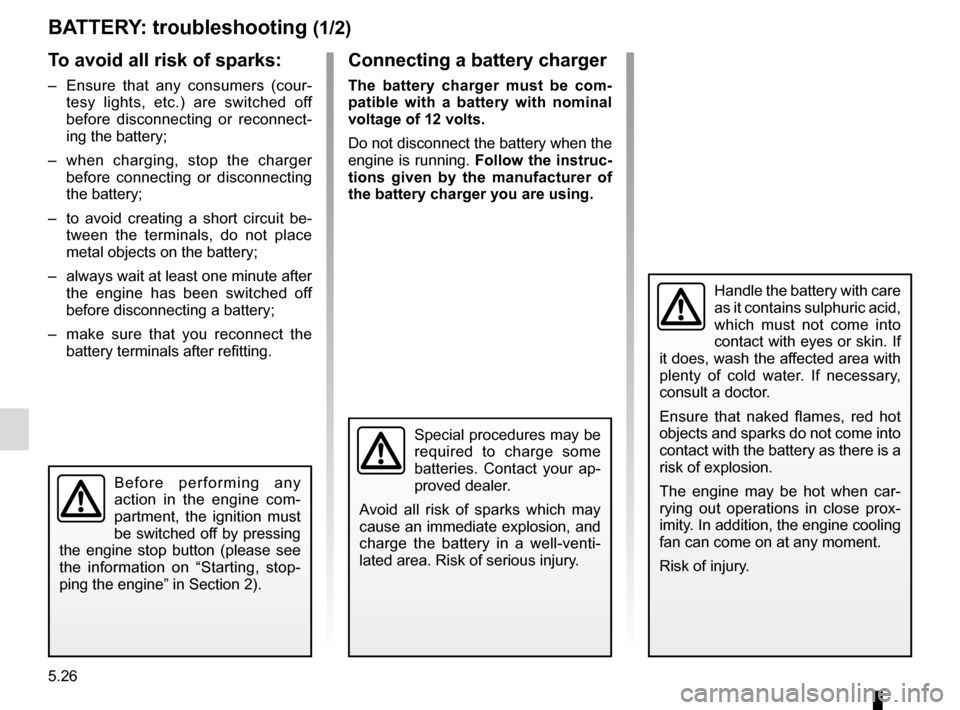
5.26
BATTERY: troubleshooting (1/2)
To avoid all risk of sparks:
– Ensure that any consumers (cour-tesy lights, etc.) are switched off
before disconnecting or reconnect-
ing the battery;
– when charging, stop the charger before connecting or disconnecting
the battery;
– to avoid creating a short circuit be- tween the terminals, do not place
metal objects on the battery;
– always wait at least one minute after the engine has been switched off
before disconnecting a battery;
– make sure that you reconnect the battery terminals after refitting.
Connecting a battery charger
The battery charger must be com-
patible with a battery with nominal
voltage of 12 volts.
Do not disconnect the battery when the
engine is running. Follow the instruc-
tions given by the manufacturer of
the battery charger you are using.
Special procedures may be
required to charge some
batteries. Contact your ap-
proved dealer.
Avoid all risk of sparks which may
cause an immediate explosion, and
charge the battery in a well-venti-
lated area. Risk of serious injury.
Handle the battery with care
as it contains sulphuric acid,
which must not come into
contact with eyes or skin. If
it does, wash the affected area with
plenty of cold water. If necessary,
consult a doctor.
Ensure that naked flames, red hot
objects and sparks do not come into
contact with the battery as there is a
risk of explosion.
The engine may be hot when car-
rying out operations in close prox-
imity. In addition, the engine cooling
fan can come on at any moment.
Risk of injury.
Before performing any
action in the engine com-
partment, the ignition must
be switched off by pressing
the engine stop button (please see
the information on “Starting, stop-
ping the engine” in Section 2).
Page 261 of 298
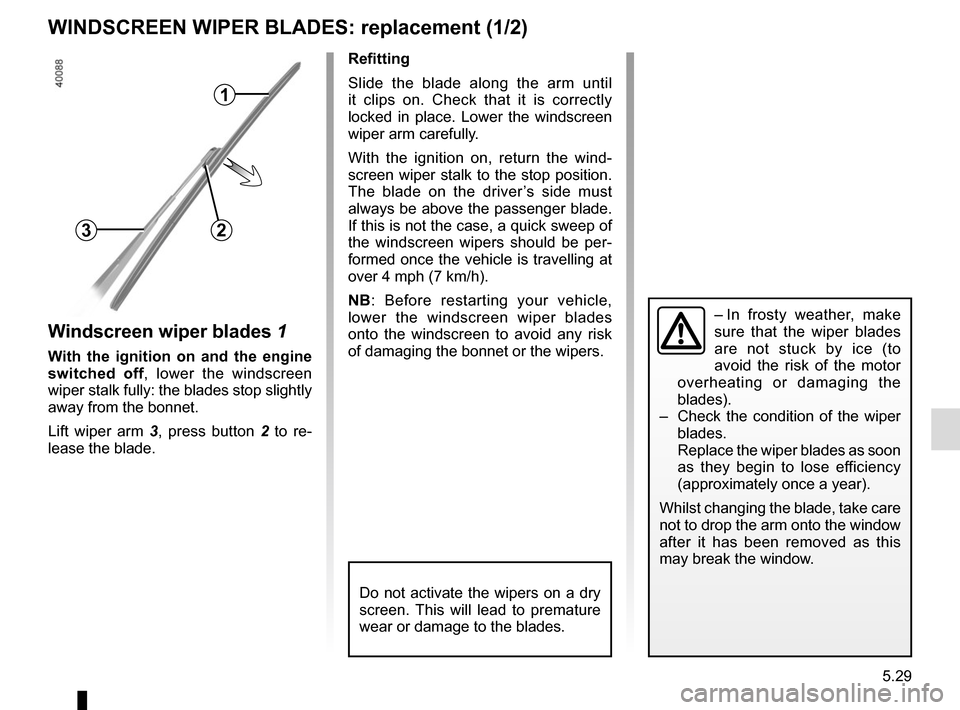
5.29
WINDSCREEN WIPER BLADES: replacement (1/2)
Windscreen wiper blades 1
With the ignition on and the engine
switched off, lower the windscreen
wiper stalk fully: the blades stop slightly
away from the bonnet.
Lift wiper arm 3 , press button 2 to re-
lease the blade.
1
23
Refitting
Slide the blade along the arm until
it clips on. Check that it is correctly
locked in place. Lower the windscreen
wiper arm carefully.
With the ignition on, return the wind-
screen wiper stalk to the stop position.
The blade on the driver’s side must
always be above the passenger blade.
If this is not the case, a quick sweep of
the windscreen wipers should be per-
formed once the vehicle is travelling at
over 4 mph (7 km/h).
NB: Before restarting your vehicle,
lower the windscreen wiper blades
onto the windscreen to avoid any risk
of damaging the bonnet or the wipers.
– In frosty weather, make
sure that the wiper blades
are not stuck by ice (to
avoid the risk of the motor
overheating or damaging the
blades).
– Check the condition of the wiper
blades.
Replace the wiper blades as soon
as they begin to lose efficiency
(approximately once a year).
Whilst changing the blade, take care
not to drop the arm onto the window
after it has been removed as this
may break the window.
Do not activate the wipers on a dry
screen. This will lead to premature
wear or damage to the blades.
Page 265 of 298
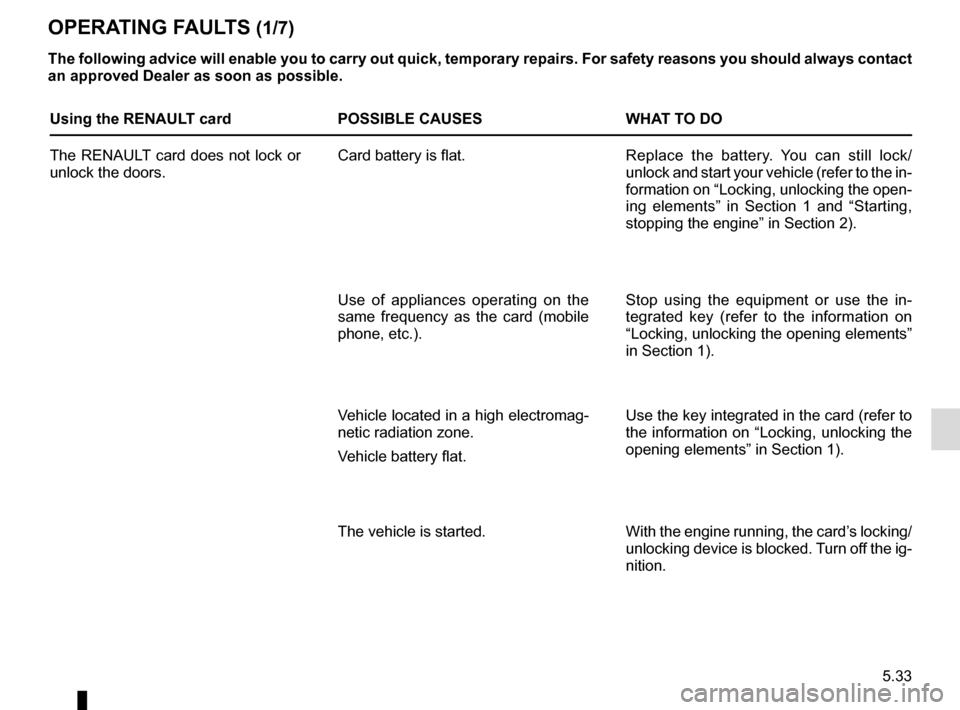
5.33
OPERATING FAULTS (1/7)
The following advice will enable you to carry out quick, temporary repai\
rs. For safety reasons you should always contact
an approved Dealer as soon as possible.
Using the RENAULT cardPOSSIBLE CAUSES WHAT TO DO
The RENAULT card does not lock or
unlock the doors. Card battery is flat.
Replace the battery. You can still lock/
unlock and start your vehicle (refer to the in-
formation on “Locking, unlocking the open-
ing elements” in Section 1 and “Starting,
stopping the engine” in Section 2).
Use of appliances operating on the
same frequency as the card (mobile
phone, etc.). Stop using the equipment or use the in-
tegrated key (refer to the information on
“Locking, unlocking the opening elements”
in Section 1).
Vehicle located in a high electromag-
netic radiation zone.
Vehicle battery flat. Use the key integrated in the card (refer to
the information on “Locking, unlocking the
opening elements” in Section 1).
The vehicle is started. With the engine running, the card’s locking/
unlocking device is blocked. Turn off the ig-
nition.
Page 266 of 298

5.34
The following advice will enable you to carry out quick, temporary repai\
rs. For safety reasons you should always contact
an approved dealer as soon as possible.
Using the remote controlPOSSIBLE CAUSES ACTION REQUIRED
The remote control does not lock or
unlock the doors. The remote control battery is flat.
Use the emergency key.
Use of appliances operating on the same
frequency as the remote control (mobile
phone, etc.). Stop using the devices or use the key.
Vehicle located in a high electromagnetic
radiation zone.
Discharged battery. Replace the battery. You can still lock/
unlock and start your vehicle (refer to the
information on “Locking/unlocking the
doors” in Section 1 and “Starting/Stopping
the engine” in Section 2).
The vehicle is started. With the engine running, the key’s locking/
unlocking device is blocked. Turn off the
ignition.
OPERATING FAULTS (2/7)
Page 267 of 298
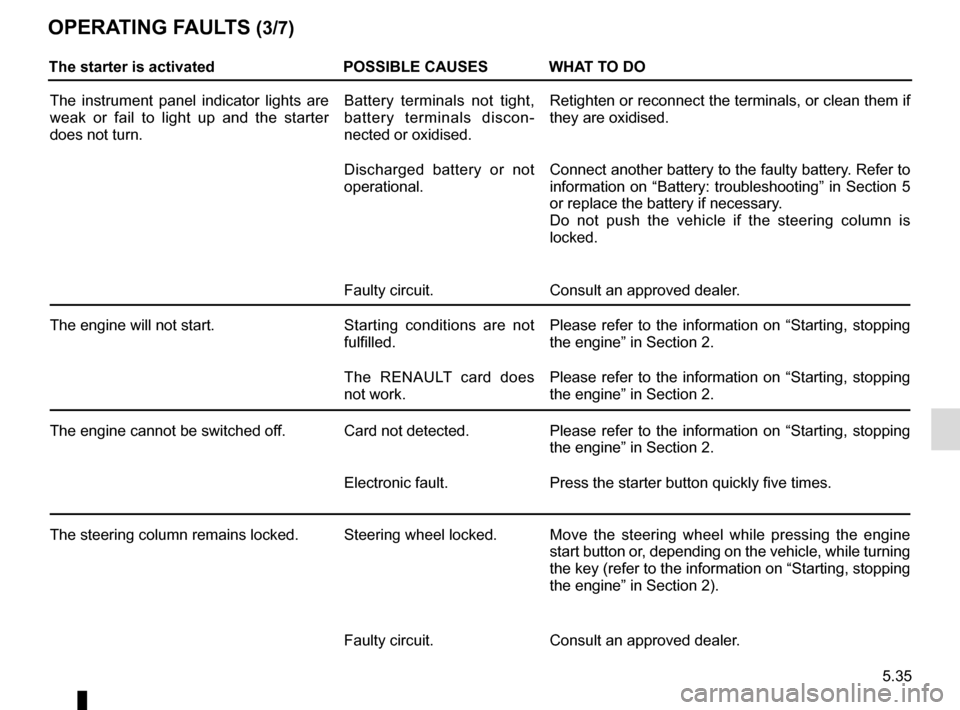
5.35
OPERATING FAULTS (3/7)
The starter is activatedPOSSIBLE CAUSES WHAT TO DO
The instrument panel indicator lights are
weak or fail to light up and the starter
does not turn. Battery terminals not tight,
battery terminals discon-
nected or oxidised.Retighten or reconnect the terminals, or clean them if
they are oxidised.
Discharged battery or not
operational. Connect another battery to the faulty battery. Refer to
information on “Battery: troubleshooting” in Section 5
or replace the battery if necessary.
Do not push the vehicle if the steering column is
locked.
Faulty circuit. Consult an approved dealer.
The engine will not start. Starting conditions are not
fulfilled.Please refer to the information on “Starting, stopping
the engine” in Section 2.
The RENAULT card does
not work. Please refer to the information on “Starting, stopping
the engine” in Section 2.
The engine cannot be switched off. Card not detected. Please refer to the information on “Starting, stopping
the engine” in Section 2.
Electronic fault. Press the starter button quickly five times.
The steering column remains locked. Steering wheel locked. Move the steering wheel while pressing the engine
start button or, depending on the vehicle, while turning
the key (refer to the information on “Starting, stopping
the engine” in Section 2).
Faulty circuit. Consult an approved dealer.
Page 292 of 298
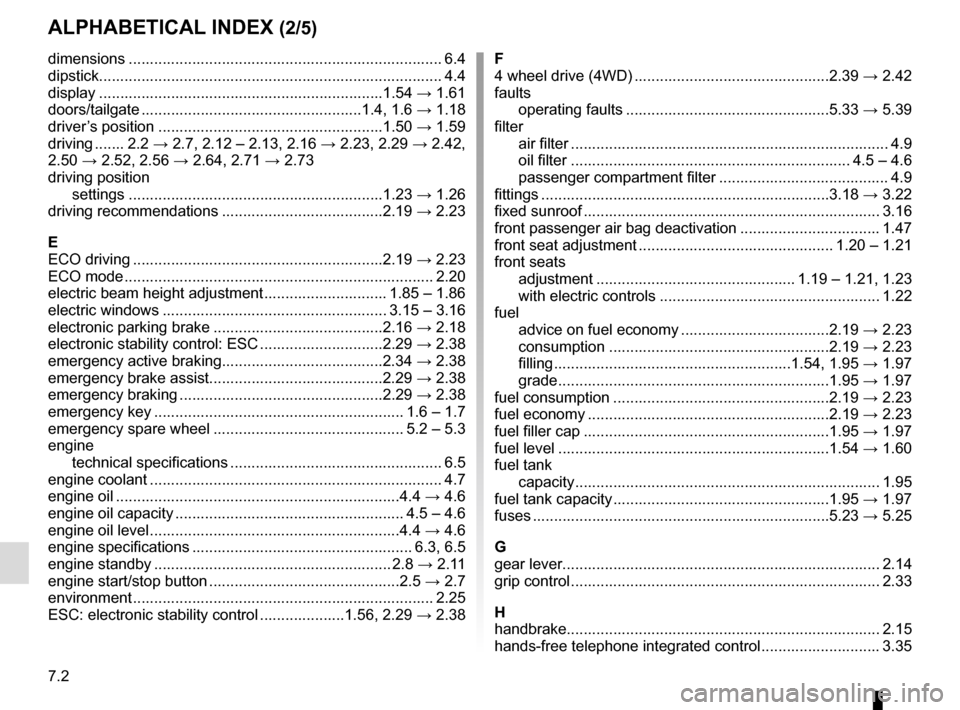
7.2
ALPHABETICAL INDEX (2/5)
dimensions .............................................................\
............. 6.4
dipstick................................................................\
................. 4.4
display ................................................................\
...1.54 → 1.61
doors/tailgate ....................................................1.4, \
1.6 → 1.18
driver’s position .....................................................1.50 → 1.59
driving ....... 2.2 → 2.7, 2.12 – 2.13, 2.16 → 2.23, 2.29 → 2.42,
2.50 → 2.52, 2.56 → 2.64, 2.71 → 2.73
driving position settings ............................................................1.2\
3 → 1.26
driving recommendations ......................................2.19 → 2.23
E
ECO driving ...........................................................2.19 → 2.23
ECO mode ........................................................................\
. 2.20
electric beam height adjustment ............................. 1.85 – 1.86
electric windows ..................................................... 3.15 – 3.16
electronic parking brake ........................................2.16 → 2.18
electronic stability control: ESC .............................2.29 → 2.38
emergency active braking......................................2.34 → 2.38
emergency brake assist.........................................2.29 → 2.38
emergency braking ................................................2.29 → 2.38
emergency key ........................................................... 1.6 – 1.7
emergency spare wheel ............................................. 5.2 – 5.3
engine technical specifications .................................................. 6.5
engine coolant ..................................................................... 4.7
engine oil ...................................................................4.4 → 4.6
engine oil capacity ...................................................... 4.5 – 4.6
engine oil level ...........................................................4.4 → 4.6
engine specifications .................................................... 6.3, 6.5
engine standby ........................................................ 2.8 → 2.11
engine start/stop button .............................................2.5 → 2.7
environment ............................................................\
........... 2.25
ESC: electronic stability control ....................1.56, 2.29 → 2.38F
4 wheel drive (4WD) ..............................................2.39
→ 2.42
faults operating faults ................................................5.33 → 5.39
filter air filter ........................................................................\
... 4.9
oil filter .................................................................. 4.5 – 4.6
passenger compartment filter ........................................ 4.9
fittings ...............................................................\
.....3.18 → 3.22
fixed sunroof ...................................................................... 3.16
front passenger air bag deactivation ................................. 1.47
front seat adjustment .............................................. 1.20 – 1.21
front seats adjustment ............................................... 1.19 – 1.21, 1.23
with electric controls .................................................... 1.22
fuel advice on fuel economy ...................................2.19 → 2.23
consumption ....................................................2.19 → 2.23
filling ........................................................1.54, 1.95 → 1.97
grade ................................................................1.\
95 → 1.97
fuel consumption ...................................................2.19 → 2.23
fuel economy .........................................................2.19 →
2.23
fuel filler cap ..........................................................1.95 → 1.97
fuel level
................................................................1.54 → 1.60
fuel tank capacity ...............................................................\
......... 1.95
fuel tank capacity ...................................................1.95 → 1.97
fuses ..................................................................\
....5.23 → 5.25
G
gear lever..............................................................\
............. 2.14
grip control ........................................................................\
. 2.33
H
handbrake...............................................................\
........... 2.15
hands-free telephone integrated control ............................ 3.35
Page 294 of 298
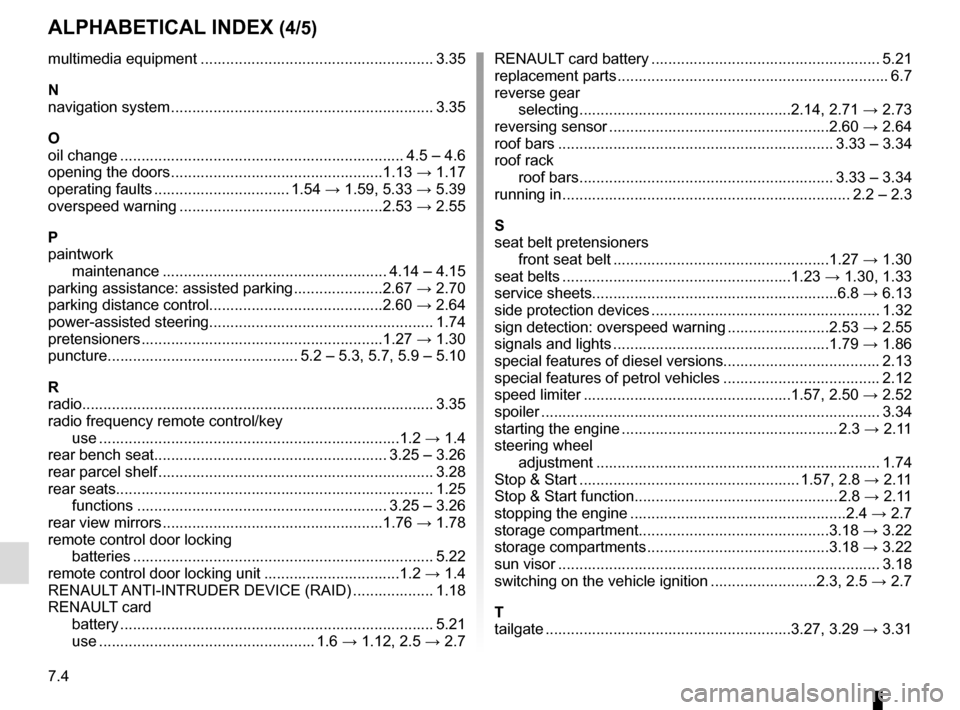
7.4
ALPHABETICAL INDEX (4/5)
multimedia equipment ....................................................... 3.35
N
navigation system .............................................................. 3.35
O
oil change ................................................................... 4.5 – 4.6
opening the doors ..................................................1.13 → 1.17
operating faults ................................ 1.54 → 1.59, 5.33 → 5.39
overspeed warning ................................................2.53 → 2.55
P
paintwork maintenance ..................................................... 4.14 – 4.15
parking assistance: assisted parking .....................2.67 → 2.70
parking distance control.........................................2.60 → 2.64
power-assisted steering.................................................\
.... 1.74
pretensioners .........................................................1\
.27 → 1.30
puncture............................................. 5.2 – 5.3, 5.7, 5.9 – 5.10
R
radio...................................................................\
................ 3.35
radio frequency remote control/key use ....................................................................\
...1.2 → 1.4
rear bench seat....................................................... 3.25 – 3.26
rear parcel shelf ................................................................. 3.28
rear seats..............................................................\
............. 1.25 functions ........................................................... 3.25 – 3.26
rear view mirrors ....................................................1.76 → 1.78
remote control door locking batteries ..............................................................\
......... 5.22
remote control door locking unit ................................1.2 → 1.4
RENAULT ANTI-INTRUDER DEVICE (RAID) ................... 1.18
RENAULT card battery ................................................................\
.......... 5.21
use ................................................... 1.6 → 1.12, 2.5 → 2.7RENAULT card battery ...................................................... 5.21
replacement parts ................................................................ 6.7
reverse gear selecting ..................................................2.14, 2.71 → 2.73
reversing sensor ....................................................2.60 → 2.64
roof bars ................................................................. 3.33 – 3.34
roof rack roof bars ............................................................ 3.33 – 3.34
running in .................................................................... 2.2 – 2.3
S
seat belt pretensioners front seat belt ...................................................1.27 → 1.30
seat belts ......................................................1.23 → 1.30, 1.33
service sheets..........................................................\
6.8 → 6.13
side protection devices ...................................................... 1.32
sign detection: overspeed warning ........................2.53 → 2.55
signals and lights ...................................................1.79 → 1.86
special features of diesel versions.....................................\
2.13
special features of petrol vehicles ..................................... 2.12
speed limiter .................................................1.57, 2.50 → 2.52
spoiler ................................................................\
................ 3.34
starting the engine ................................................... 2.3 → 2.11
steering wheel adjustment .............................................................\
...... 1.74
Stop & Start .................................................... 1.57, 2.8 → 2.11
Stop & Start function................................................ 2.8 → 2.11
stopping the engine ...................................................2.4 → 2.7
storage compartment.............................................3.18 → 3.22
storage compartments ...........................................3.18 → 3.22
sun visor ........................................................................\
.... 3.18
switching on the vehicle ignition .........................2.3, 2.5 → 2.7
T
tailgate ..........................................................3.27,\
3.29 → 3.31